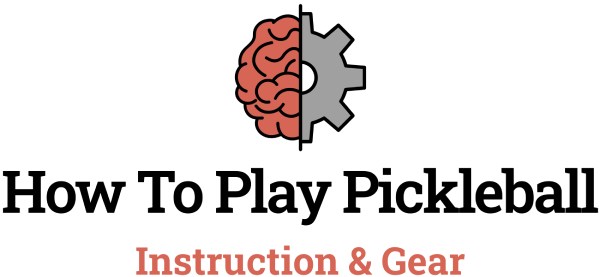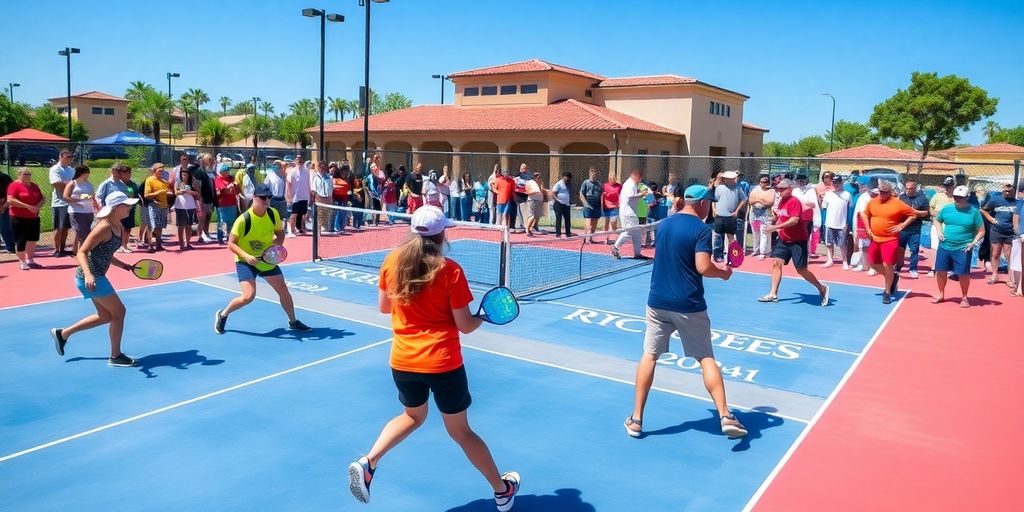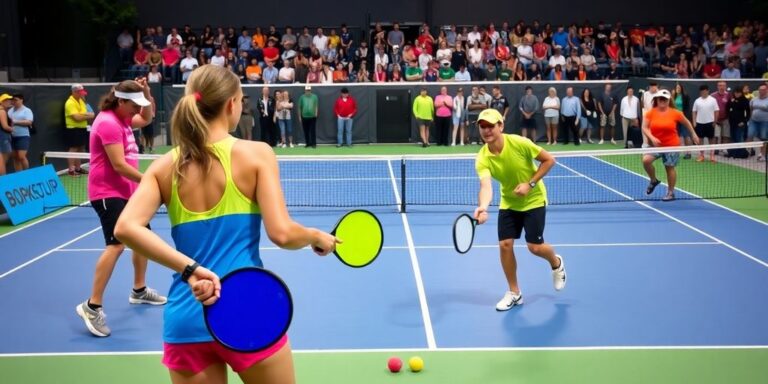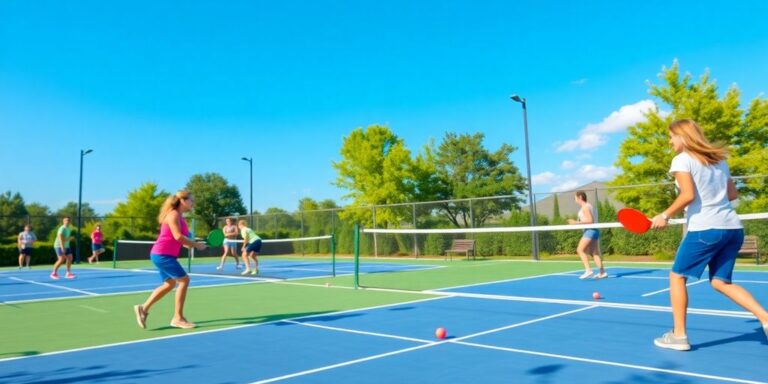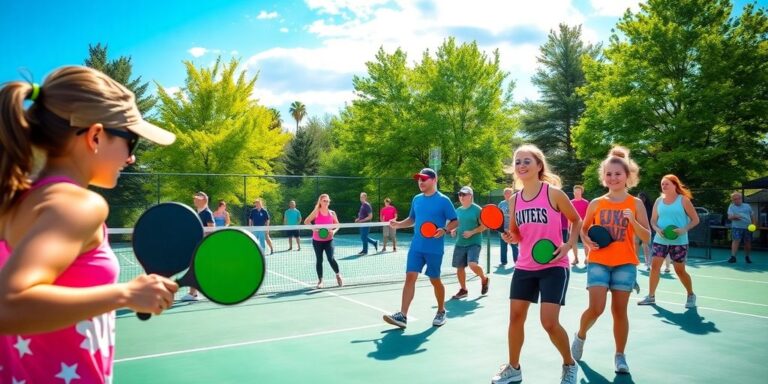Pickleball has become a household name in the U.S., but where did it all begin? This sport, which blends elements of tennis, badminton, and table tennis, started off as a simple backyard game in the 1960s. Over the years, it has transformed into a global phenomenon, attracting players from all walks of life. In this article, we will trace the pickleball origin, exploring its early days, cultural influences, and the factors contributing to its rapid rise in popularity.
Key Takeaways
- Pickleball originated in the 1960s as a backyard game in the U.S.
- The sport draws inspiration from various paddle sports, especially badminton and table tennis.
- Pickleball has seen significant international growth, particularly in Europe, Australia, and South America.
- Community involvement and programs in schools are key to pickleball’s rise in America.
- The sport’s accessibility and social nature make it appealing to players of all ages and backgrounds.
The Early Days of Pickleball

Origins in the 1960s
So, pickleball. It’s everywhere now, right? But where did it even come from? Well, it all started back in the summer of ’65 on Bainbridge Island, Washington. Joel Pritchard, Bill Bell, and Barney McCallum are the names you need to know. The story goes that the kids were bored, and they needed something to do. They grabbed whatever equipment they could find – a wiffle ball, some paddles, and a badminton net. And just like that, pickleball was born. It wasn’t pretty at first, but hey, necessity is the mother of invention, right?
The Backyard Game
At first, it was just a fun thing for the families. They tweaked the rules as they went, figuring out what worked and what didn’t. The original court was badminton-sized, and the net was set at badminton height. But they quickly realized that the ball bounced pretty well on asphalt, so they started lowering the net. They were just messing around, but they were onto something. It was a game that anyone could pick up pretty quickly, regardless of athletic ability. It was all about having fun and getting some exercise. It was a true backyard pastime.
Initial Popularity in the U.S.
It didn’t take long for the game to spread beyond Bainbridge Island. Word got around, and other families started building their own courts. By the early 70s, there were pickleball tournaments popping up. The sport started to gain traction in retirement communities, because it was easy on the joints and a good way to stay active. It was also a very social game, which made it appealing to people who were looking to make new friends. It wasn’t an overnight sensation, but it was definitely building momentum. The intense matches were just starting to take off.
It’s funny to think that something that started as a way to entertain bored kids has turned into a national phenomenon. It just goes to show that sometimes the best things in life are the ones that are simple and unpretentious.
Cultural Influences on Pickleball
Paddle Sports in Asia
Paddle sports have a long and interesting history in Asia. Think about it: badminton started in China over 2,000 years ago! It used shuttlecocks and light rackets, and it became super popular all over. Then there’s table tennis, which showed up in Japan in the late 1800s and became a huge deal. These sports set the stage for pickleball’s growth, showing that Asia loves racket sports.
Evolution of Racket Sports
Racket sports have changed a lot over time. They’ve gone from simple games to big international competitions. Badminton and table tennis are great examples. They started small but grew into major sports with lots of fans and players. This evolution helped make people open to new sports like pickleball. It’s cool to see how these games have changed and influenced each other. Pickleball combines elements of badminton, tennis, and table tennis to create a fast-paced, engaging game suitable for players of all ages.
Impact of Badminton and Table Tennis
Badminton and table tennis really paved the way for pickleball. They showed that racket sports could be fun, social, and competitive. Because of them, people were already familiar with the basic ideas of racket sports, which made it easier for pickleball to catch on. Plus, these sports created a culture of playing and competing that helped pickleball gain popularity too.
Pickleball’s rise is partly because people already liked badminton and table tennis. These sports made it easier for pickleball to find players and fans. It’s like they built the foundation for pickleball’s success.
Here’s a quick look at how these sports have grown:
- Badminton: Started in China, spread worldwide.
- Table Tennis: Became popular in Japan, now a global sport.
- Pickleball: Gaining popularity fast, especially in the U.S. and Asia. Key developments have contributed to the sport’s increasing popularity.
The Global Expansion of Pickleball
Introduction to International Markets
Pickleball’s journey from a backyard pastime to a global phenomenon is pretty interesting. It started gaining traction outside the U.S. in the early 2000s, largely thanks to expat communities introducing the sport to new countries. It wasn’t an overnight success, but the seeds were planted. Now, you can find pickleball courts in unexpected places, and the sport’s inclusive nature is a big reason why.
Growth in Europe and Australia
Europe and Australia have really embraced pickleball. What’s cool is how quickly it’s been adopted by local sports clubs and community centers. The accessibility of pickleball makes it easy for people of all ages to pick up, and that’s helped it spread like wildfire. Plus, the social aspect of the game is a huge draw. It’s not just about the exercise; it’s about making connections and having fun.
Emerging Popularity in South America
South America is the next frontier for pickleball. While it’s still in the early stages compared to other regions, there’s a growing buzz around the sport. More and more people are discovering the benefits of pickleball, and local organizations are starting to promote it. It’s exciting to see how pickleball is adapting to different cultures and communities, and South America is definitely one to watch. The rapid growth of pickleball in 2023 is a testament to its universal appeal.
Pickleball’s global expansion isn’t just about the sport itself; it’s about building communities and promoting an active lifestyle. The game’s simplicity and adaptability make it a perfect fit for diverse cultures and environments. As more countries embrace pickleball, it’s clear that this sport has a bright future on the world stage. The global support for the sport is growing every day.
The Rise of Pickleball in America
Community Engagement
Pickleball’s growth in America is fueled by strong community engagement. Local clubs and organizations play a huge role in introducing the sport to new players. They organize events, clinics, and leagues that cater to different skill levels. This creates a welcoming environment where people can learn, compete, and socialize. It’s not just about the game; it’s about building connections and having fun. The social aspect is a big draw for many people. You can find local communities easily.
Pickleball in Schools and Parks
Pickleball is popping up everywhere! Schools are adding it to their physical education programs, and parks are building dedicated courts. This increased accessibility makes it easier for people of all ages to try the sport. The low cost of entry is another factor. You don’t need a ton of expensive equipment to get started, which makes it appealing to schools and community centers with limited budgets. More and more people are discovering the joy of pickleball because it’s right there in their neighborhoods. The number of pickleball courts has increased dramatically.
Demographics of Players
Pickleball attracts a diverse group of players. While it’s popular among older adults, younger generations are also getting involved. Families are playing together, and college students are forming clubs. The sport’s adaptability makes it appealing to people with different athletic backgrounds. Whether you’re a seasoned athlete or someone who’s never played a racket sport before, you can pick up pickleball relatively quickly. It’s a sport that truly transcends age and ability.
Pickleball’s rise in America is a testament to its inclusive nature and social appeal. It’s more than just a sport; it’s a community, a way to stay active, and a whole lot of fun. As more people discover the joys of pickleball, its popularity is sure to continue to soar.
The Unique Appeal of Pickleball

Pickleball’s popularity isn’t just a fad; it’s rooted in several factors that make it uniquely appealing to a wide range of people. It’s easy to learn, social, and provides a good workout, making it a triple threat in the world of recreational sports. Let’s explore what makes pickleball stand out.
Accessibility for All Ages
One of the biggest draws of pickleball is its accessibility. Unlike tennis, which can be tough on the joints and requires a lot of running, pickleball is played on a smaller court with an underhand serve, making it easier on the body. This means people of all ages and fitness levels can pick up a paddle and start playing quickly. You don’t need years of experience to enjoy a game, and the rules are simple enough for beginners to grasp in minutes. This makes it a great option for families, seniors, and anyone looking for a fun way to stay active. The engaging nature of pickleball makes it a great option for all ages.
Social and Competitive Aspects
Pickleball is inherently social. The smaller court size encourages interaction between players, and the games are often played in doubles, fostering teamwork and camaraderie. It’s common to see people chatting and laughing between points, creating a friendly and welcoming atmosphere. But don’t let the social aspect fool you – pickleball can also be incredibly competitive. Many players enjoy the strategic elements of the game, such as dinking, volleying, and placement shots. Whether you’re looking for a casual game with friends or a serious tournament, pickleball offers something for everyone. The rapid growth of pickleball is a testament to its social and competitive aspects.
Health Benefits of Playing
Beyond the social and fun aspects, pickleball offers significant health benefits. It’s a great way to get your heart rate up, improve your cardiovascular health, and burn calories. The constant movement and quick reflexes required in the game can also improve your agility, balance, and coordination. Plus, because it’s a low-impact sport, it’s easier on the joints than many other forms of exercise. Here’s a quick look at some of the health benefits:
- Improved cardiovascular health
- Increased agility and balance
- Enhanced coordination
- Low-impact exercise
Pickleball is more than just a game; it’s a community. The welcoming atmosphere and the ease of learning make it a sport that people can enjoy for years to come. It’s a great way to stay active, meet new people, and have fun, all at the same time.
The Future of Pickleball
Trends in Participation
Pickleball’s growth has been nothing short of explosive, and all signs point to that continuing. The sport’s accessibility is a huge factor. It’s easy to learn, doesn’t require a ton of specialized equipment, and can be played by people of all ages and fitness levels. This makes it appealing to a broad audience, from families looking for a fun activity to seniors seeking a low-impact way to stay active. The growth of pickleball is expected to continue, with more and more people discovering the joys of the game.
- Increased participation in recreational leagues.
- More dedicated pickleball facilities being built.
- Growing interest from younger demographics.
Potential for Professional Leagues
The professional pickleball scene is still relatively young, but it’s rapidly evolving. There are already several professional tours and organizations, and the level of competition is getting higher all the time. As the sport grows, we can expect to see even more investment in professional pickleball, with bigger tournaments, more sponsorships, and increased media coverage. It’s not hard to imagine a future where professional pickleball players are household names, and the sport is a major draw for fans around the world. The pickleball market is projected to grow significantly, which will likely fuel the professional scene.
Sustainability of Growth
One of the big questions surrounding pickleball is whether its current growth rate is sustainable. Can the sport maintain its momentum, or will it eventually plateau? While it’s impossible to say for sure, there are several reasons to be optimistic about pickleball’s long-term prospects. The sport’s inclusive nature, its strong social component, and its relatively low cost all contribute to its appeal. Plus, the fact that it can be played indoors or outdoors makes it a year-round activity in many parts of the world. As long as the pickleball community continues to focus on making the sport accessible and enjoyable for everyone, there’s no reason to think it can’t continue to thrive for years to come.
Pickleball’s future hinges on maintaining its welcoming atmosphere and adapting to the needs of its growing player base. Investing in infrastructure, training qualified instructors, and promoting fair play will be key to ensuring the sport’s continued success.
Pickleball is growing fast, and its future looks bright! More people are discovering this fun sport, and new courts are popping up everywhere. If you want to stay updated on the latest news and tips about pickleball, visit our website. Join the excitement and be part of the pickleball community!
Wrapping Up the Journey of Pickleball
So, there you have it. Pickleball has come a long way from its backyard beginnings to becoming a favorite sport for many. It’s amazing how a simple game can bring people together, no matter their age or skill level. The growth we’ve seen in 2023 shows that this sport is here to stay. With courts popping up everywhere and tournaments happening around the globe, it’s clear that Pickleball is more than just a trend. It’s a community, a way to stay active, and a whole lot of fun. If you haven’t tried it yet, maybe it’s time to grab a paddle and join in on the excitement!
Frequently Asked Questions
What is pickleball?
Pickleball is a fun sport that combines elements from tennis, badminton, and table tennis. It’s played with a paddle and a plastic ball with holes.
Where did pickleball come from?
Pickleball started in the mid-1960s in the United States. It was created as a backyard game for families.
Why is pickleball so popular?
People love pickleball because it’s easy to learn, can be played by anyone, and is a great way to socialize and stay active.
Is pickleball played all over the world?
Yes! Pickleball has spread to many countries, including those in Europe, Australia, and South America, and it continues to grow in popularity.
Who can play pickleball?
Anyone can play pickleball, regardless of age or skill level. It’s designed to be accessible for all.
What are the health benefits of playing pickleball?
Playing pickleball helps improve fitness, coordination, and social skills. It’s a great way to stay healthy and have fun.
